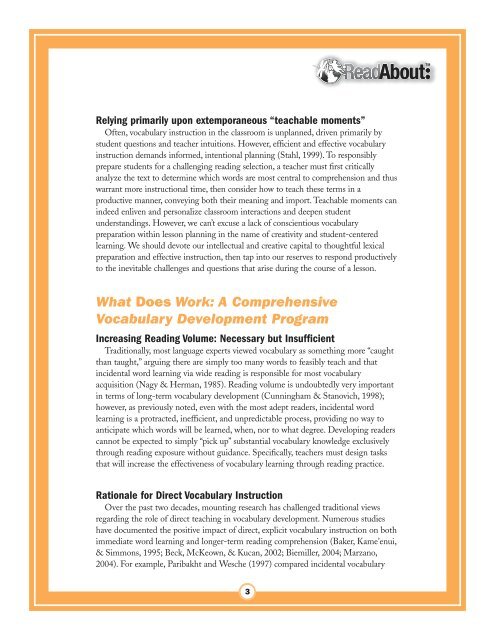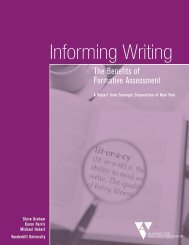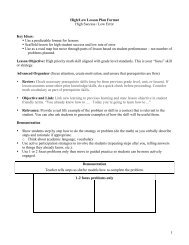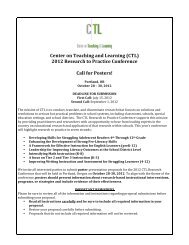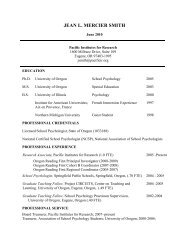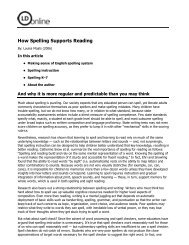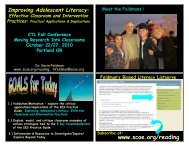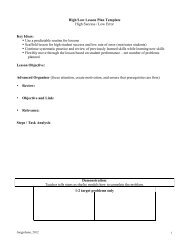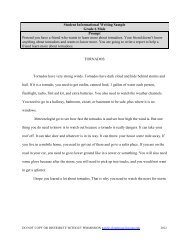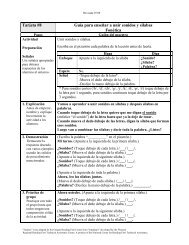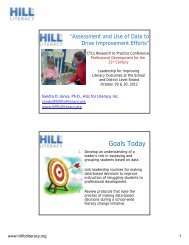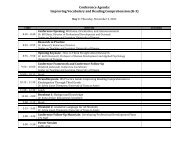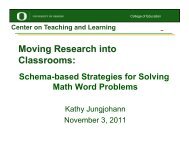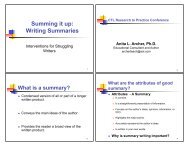Narrowing the Language Gap: - Center on Teaching and Learning ...
Narrowing the Language Gap: - Center on Teaching and Learning ...
Narrowing the Language Gap: - Center on Teaching and Learning ...
- No tags were found...
You also want an ePaper? Increase the reach of your titles
YUMPU automatically turns print PDFs into web optimized ePapers that Google loves.
TMRelying primarily up<strong>on</strong> extemporaneous “teachable moments”Often, vocabulary instructi<strong>on</strong> in <str<strong>on</strong>g>the</str<strong>on</strong>g> classroom is unplanned, driven primarily bystudent questi<strong>on</strong>s <strong>and</strong> teacher intuiti<strong>on</strong>s. However, efficient <strong>and</strong> effective vocabularyinstructi<strong>on</strong> dem<strong>and</strong>s informed, intenti<strong>on</strong>al planning (Stahl, 1999). To resp<strong>on</strong>siblyprepare students for a challenging reading selecti<strong>on</strong>, a teacher must first criticallyanalyze <str<strong>on</strong>g>the</str<strong>on</strong>g> text to determine which words are most central to comprehensi<strong>on</strong> <strong>and</strong> thuswarrant more instructi<strong>on</strong>al time, <str<strong>on</strong>g>the</str<strong>on</strong>g>n c<strong>on</strong>sider how to teach <str<strong>on</strong>g>the</str<strong>on</strong>g>se terms in aproductive manner, c<strong>on</strong>veying both <str<strong>on</strong>g>the</str<strong>on</strong>g>ir meaning <strong>and</strong> import. Teachable moments canindeed enliven <strong>and</strong> pers<strong>on</strong>alize classroom interacti<strong>on</strong>s <strong>and</strong> deepen studentunderst<strong>and</strong>ings. However, we can’t excuse a lack of c<strong>on</strong>scientious vocabularypreparati<strong>on</strong> within less<strong>on</strong> planning in <str<strong>on</strong>g>the</str<strong>on</strong>g> name of creativity <strong>and</strong> student-centeredlearning. We should devote our intellectual <strong>and</strong> creative capital to thoughtful lexicalpreparati<strong>on</strong> <strong>and</strong> effective instructi<strong>on</strong>, <str<strong>on</strong>g>the</str<strong>on</strong>g>n tap into our reserves to resp<strong>on</strong>d productivelyto <str<strong>on</strong>g>the</str<strong>on</strong>g> inevitable challenges <strong>and</strong> questi<strong>on</strong>s that arise during <str<strong>on</strong>g>the</str<strong>on</strong>g> course of a less<strong>on</strong>.What Does Work: A ComprehensiveVocabulary Development ProgramIncreasing Reading Volume: Necessary but InsufficientTraditi<strong>on</strong>ally, most language experts viewed vocabulary as something more “caughtthan taught,” arguing <str<strong>on</strong>g>the</str<strong>on</strong>g>re are simply too many words to feasibly teach <strong>and</strong> thatincidental word learning via wide reading is resp<strong>on</strong>sible for most vocabularyacquisiti<strong>on</strong> (Nagy & Herman, 1985). Reading volume is undoubtedly very importantin terms of l<strong>on</strong>g-term vocabulary development (Cunningham & Stanovich, 1998);however, as previously noted, even with <str<strong>on</strong>g>the</str<strong>on</strong>g> most adept readers, incidental wordlearning is a protracted, inefficient, <strong>and</strong> unpredictable process, providing no way toanticipate which words will be learned, when, nor to what degree. Developing readerscannot be expected to simply “pick up” substantial vocabulary knowledge exclusivelythrough reading exposure without guidance. Specifically, teachers must design tasksthat will increase <str<strong>on</strong>g>the</str<strong>on</strong>g> effectiveness of vocabulary learning through reading practice.Rati<strong>on</strong>ale for Direct Vocabulary Instructi<strong>on</strong>Over <str<strong>on</strong>g>the</str<strong>on</strong>g> past two decades, mounting research has challenged traditi<strong>on</strong>al viewsregarding <str<strong>on</strong>g>the</str<strong>on</strong>g> role of direct teaching in vocabulary development. Numerous studieshave documented <str<strong>on</strong>g>the</str<strong>on</strong>g> positive impact of direct, explicit vocabulary instructi<strong>on</strong> <strong>on</strong> bothimmediate word learning <strong>and</strong> l<strong>on</strong>ger-term reading comprehensi<strong>on</strong> (Baker, Kame’enui,& Simm<strong>on</strong>s, 1995; Beck, McKeown, & Kucan, 2002; Biemiller, 2004; Marzano,2004). For example, Paribakht <strong>and</strong> Wesche (1997) compared incidental vocabulary3


